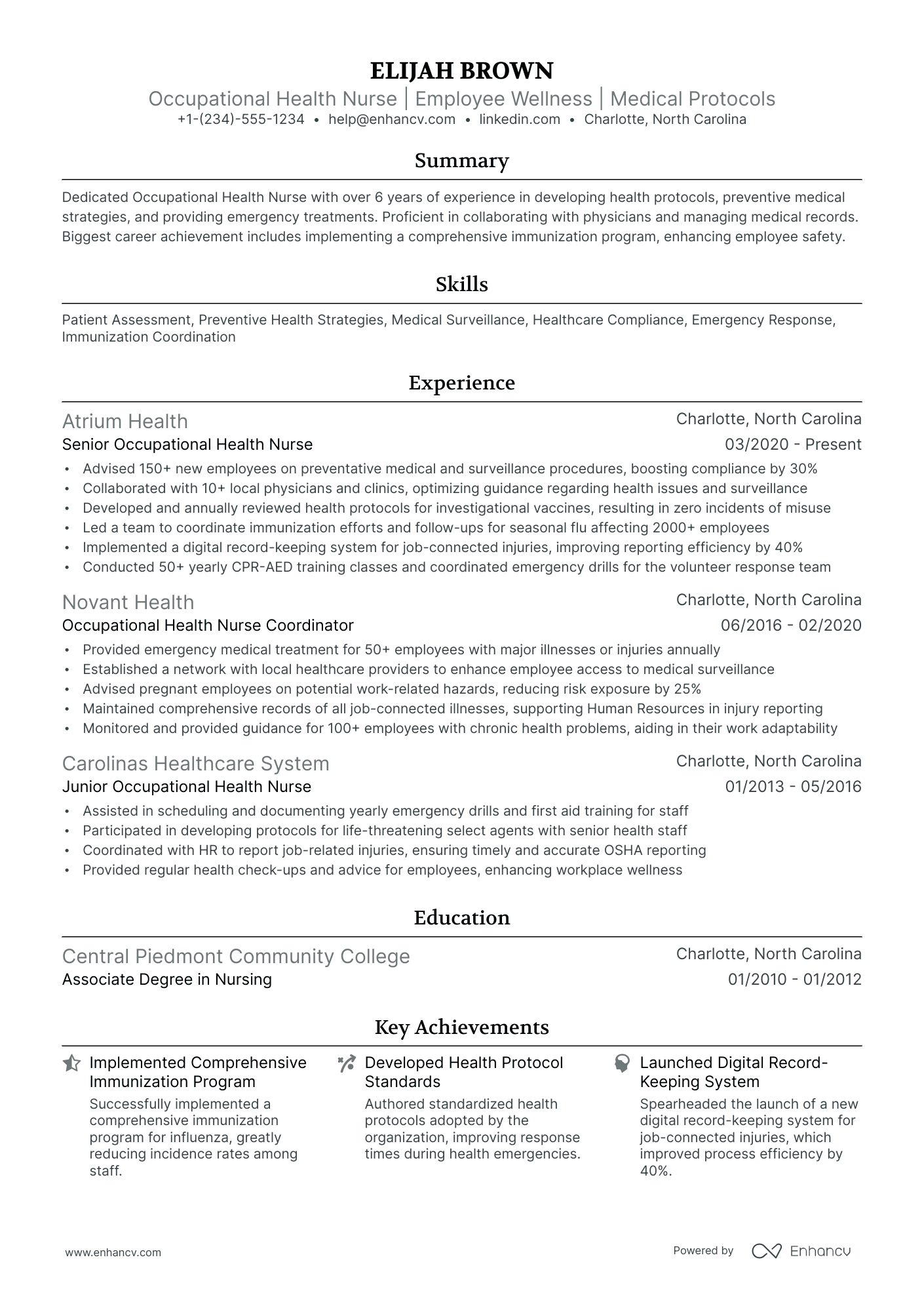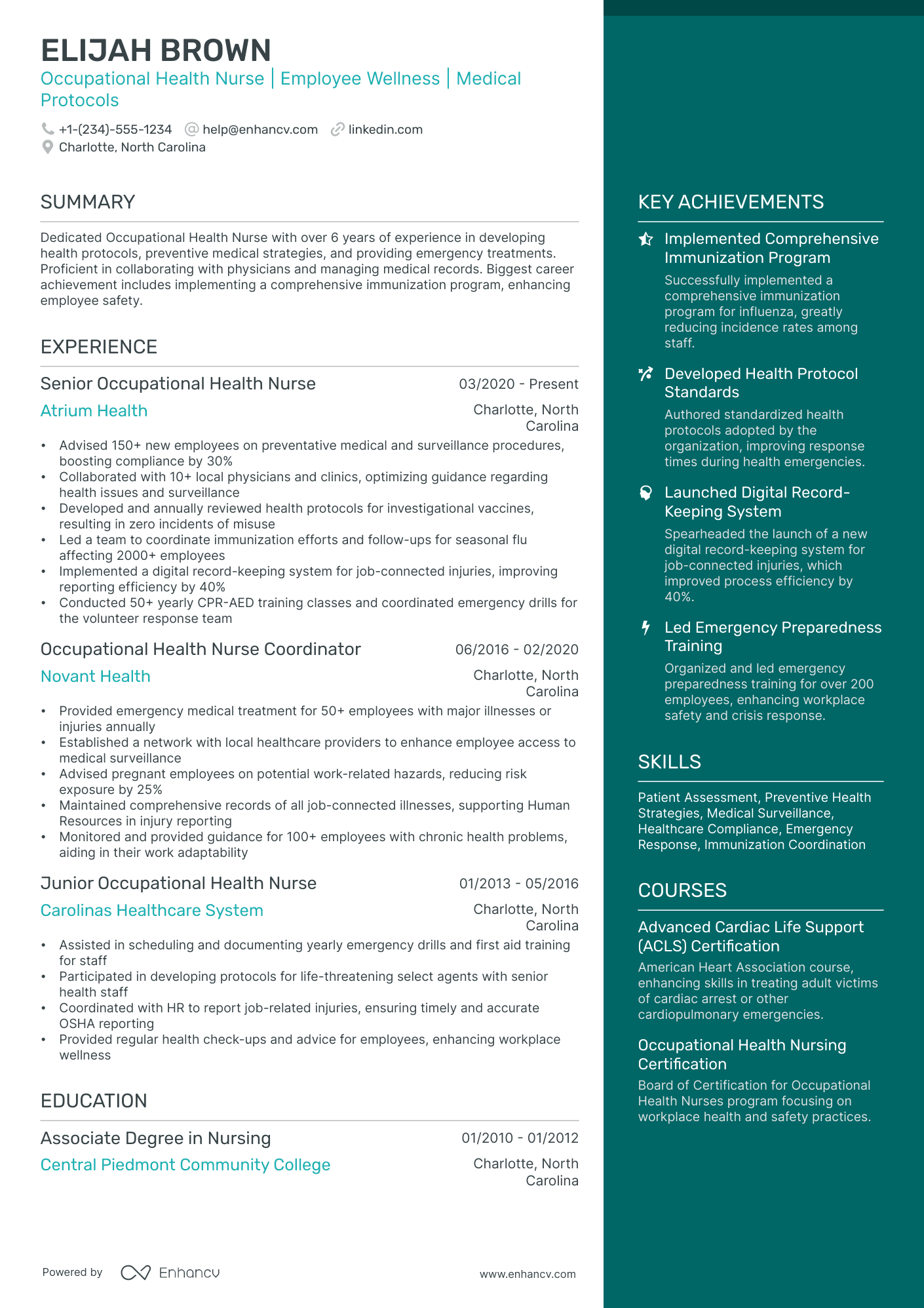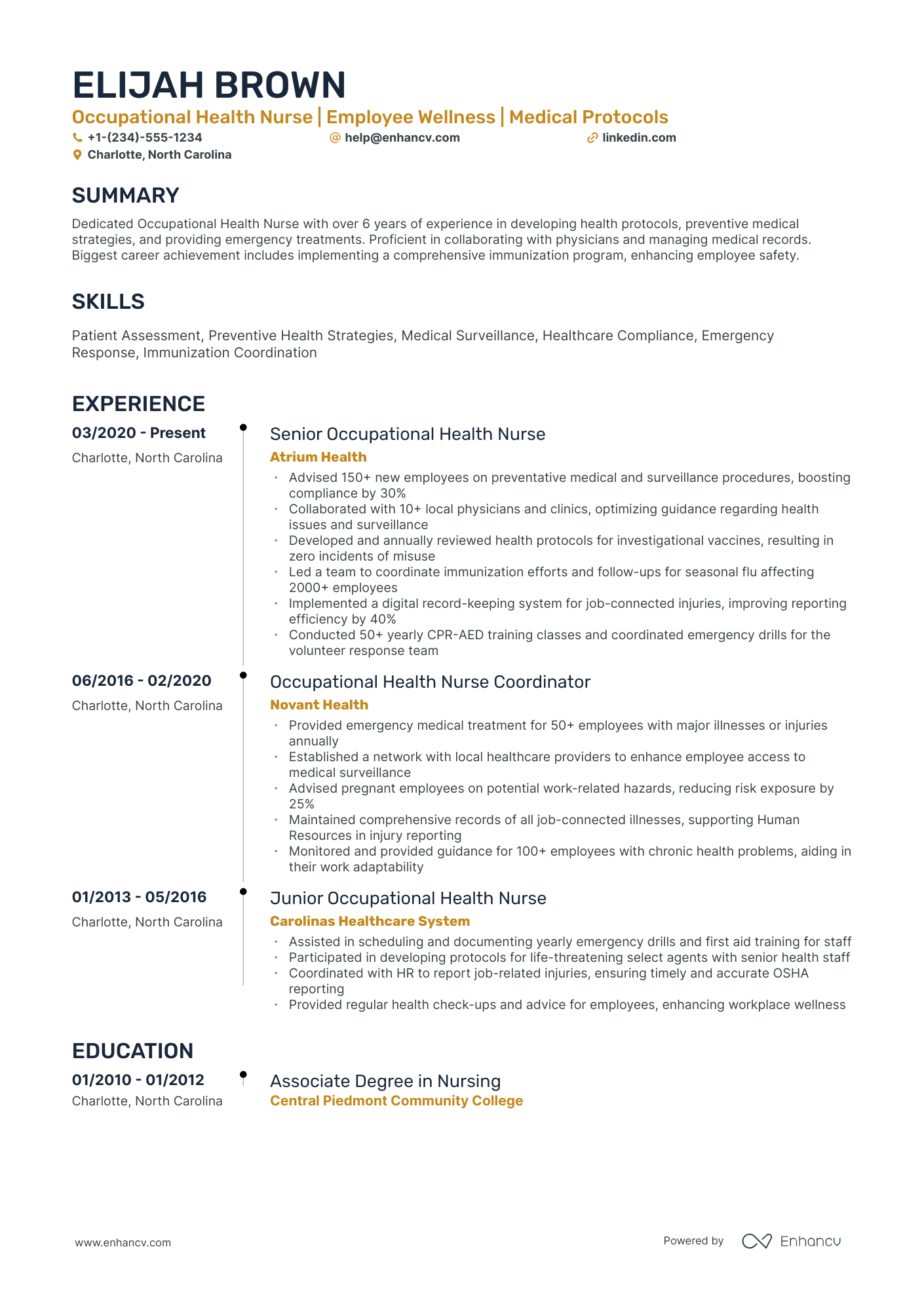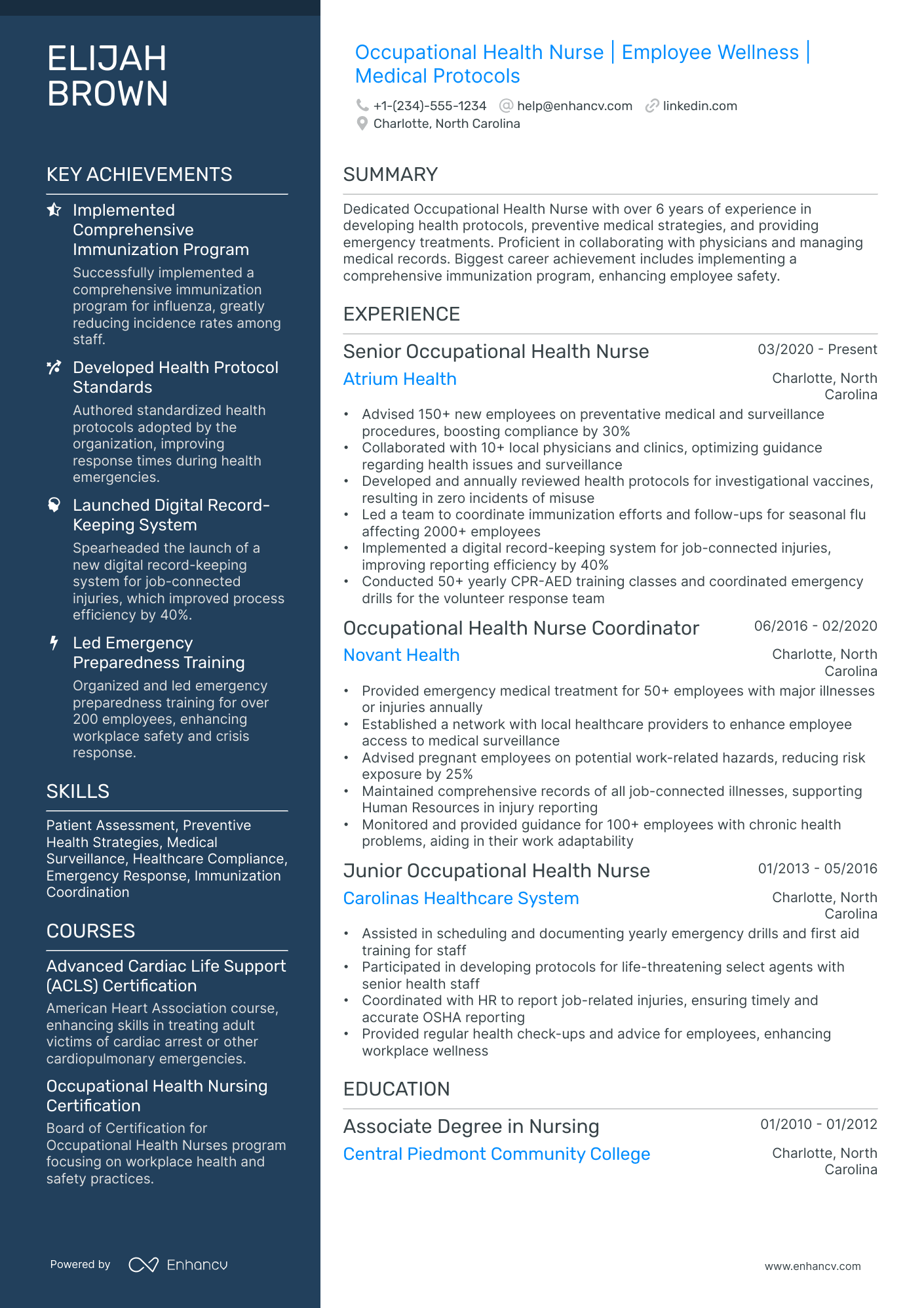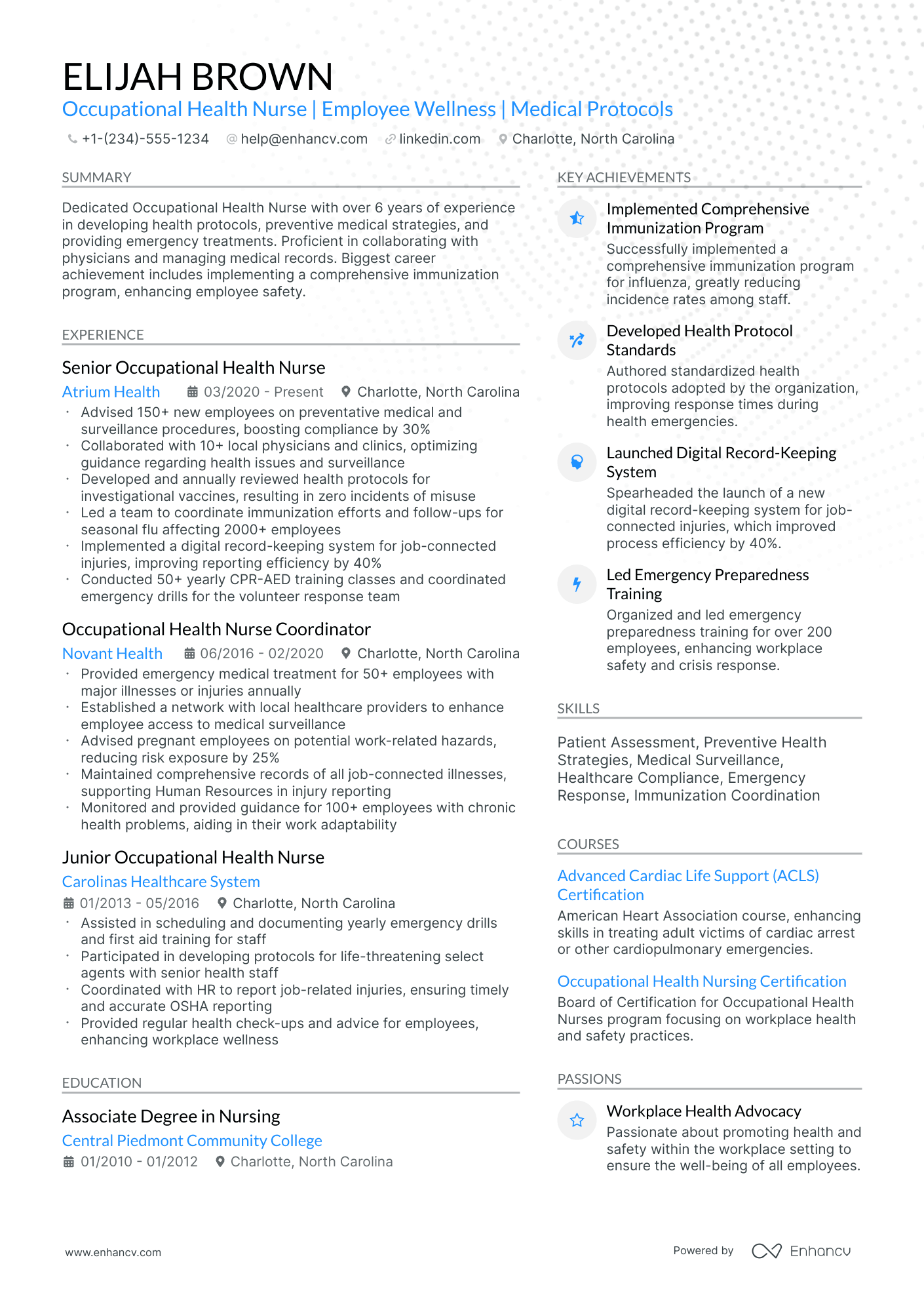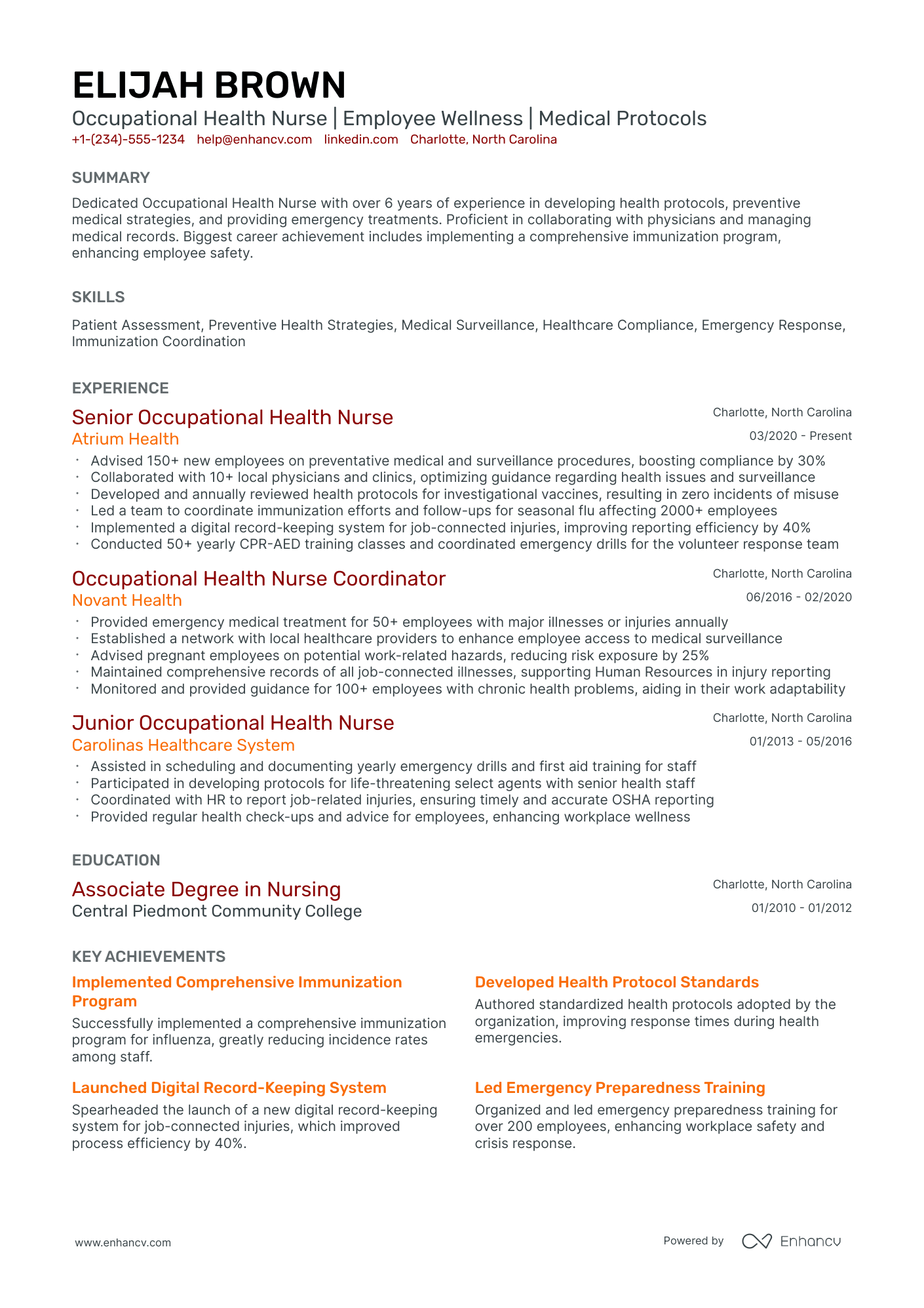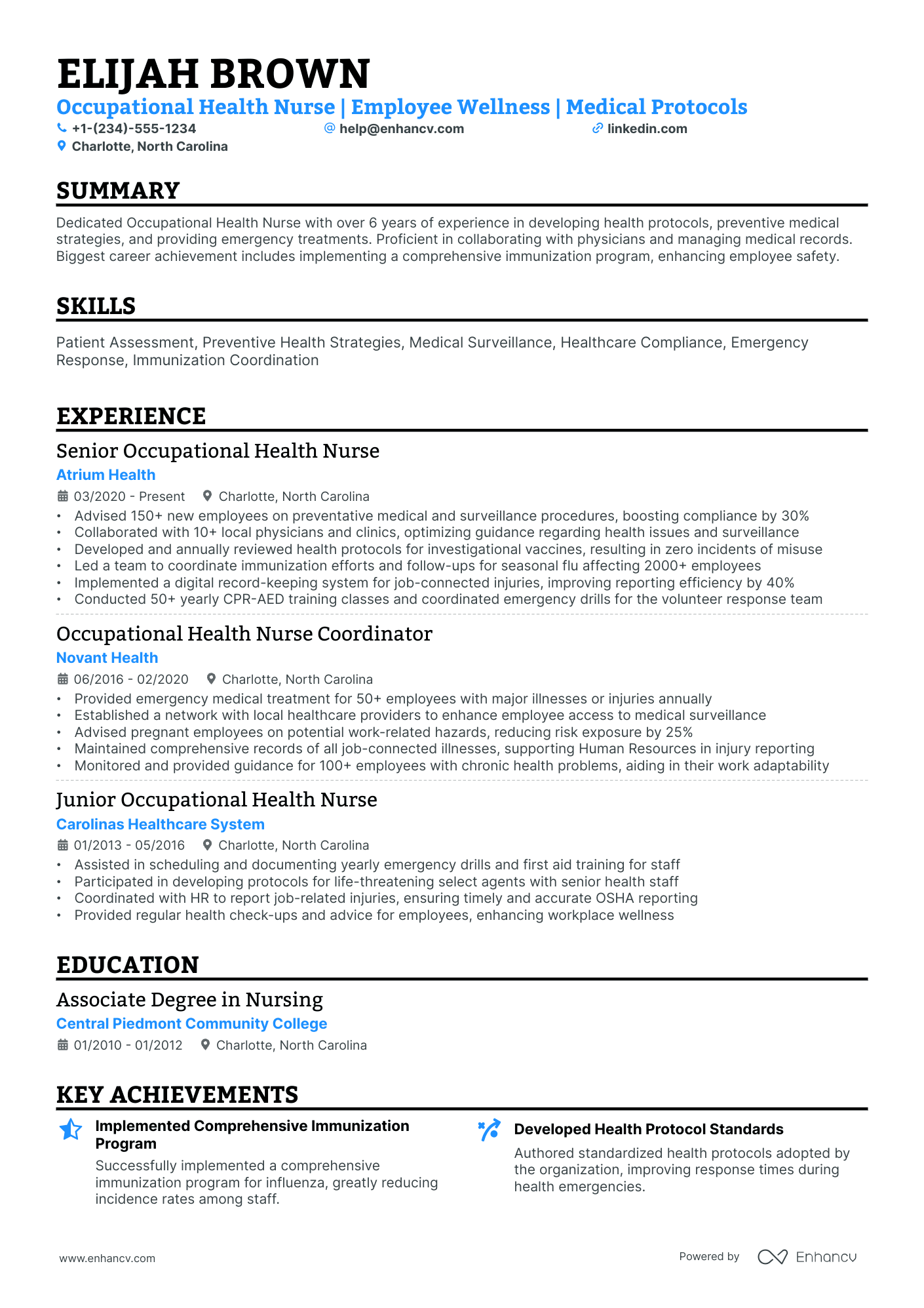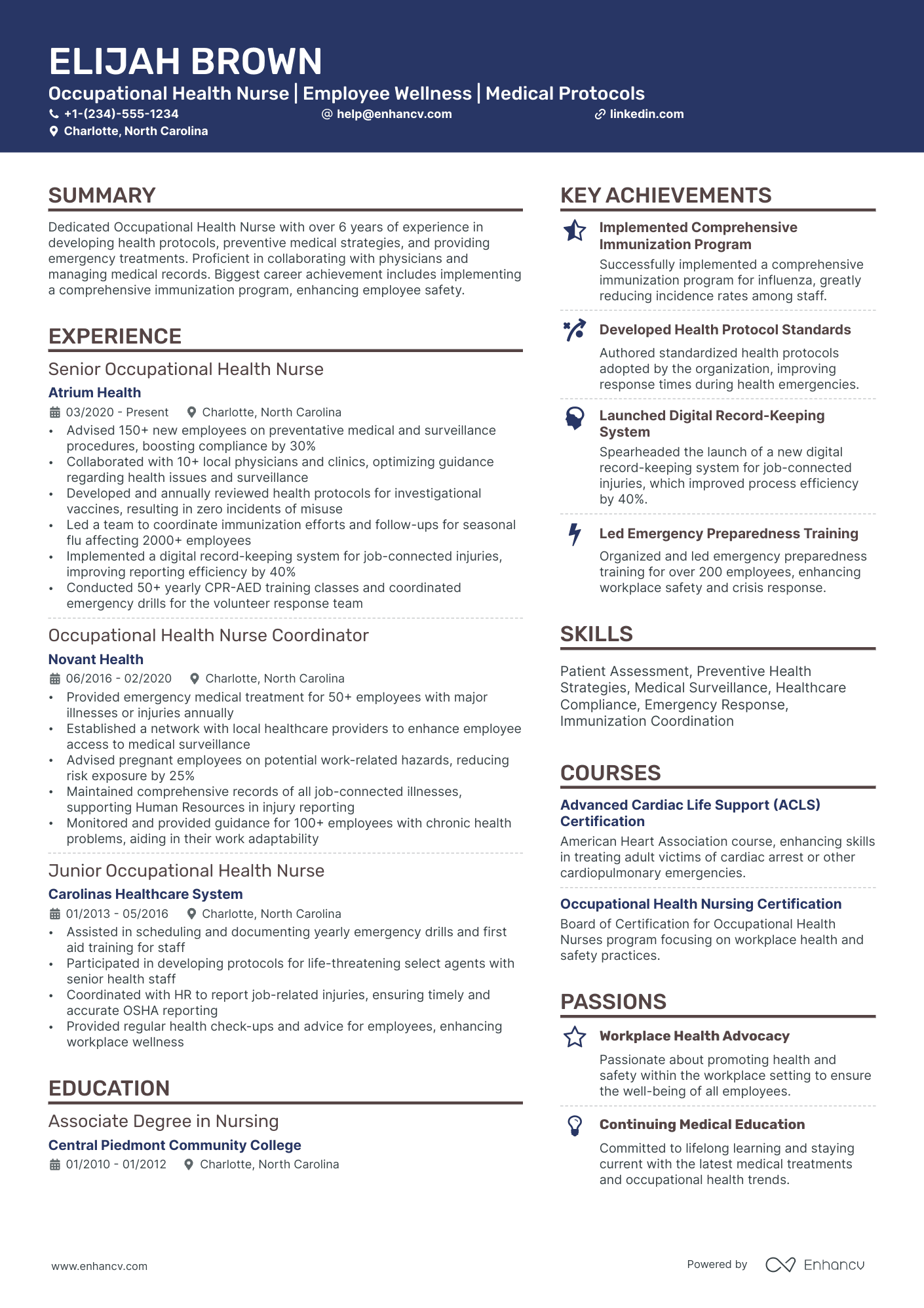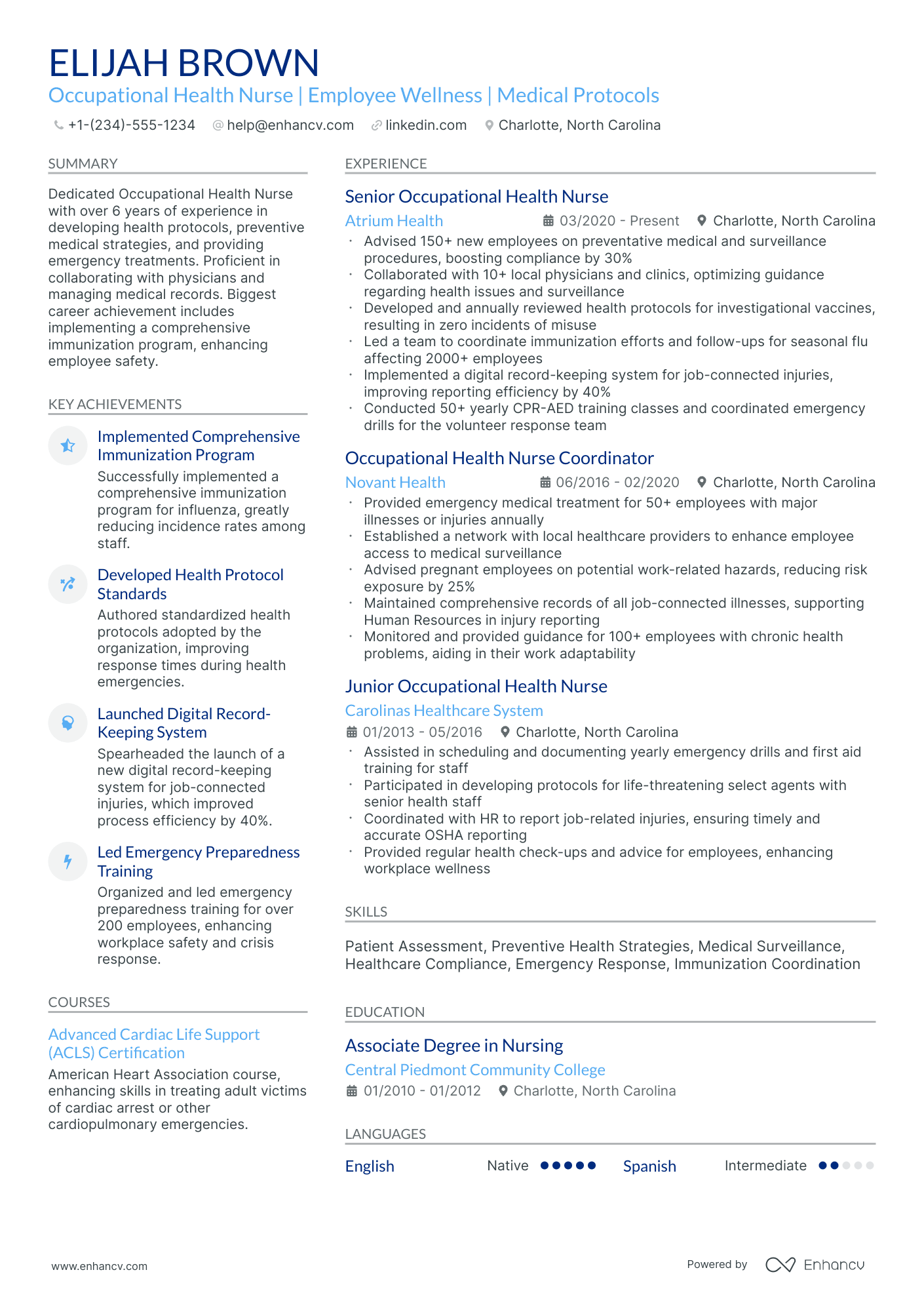As an occupational health nurse, articulating your diverse experience in disease prevention and workplace safety in a concise resume can be challenging. Our guide offers tailored strategies to help you highlight your unique qualifications and ensure your resume stands out to prospective employers.
- Sample industry-leading examples to learn how to write your best resume yet.
- Improve the experience, education, and achievements section of your resume with insights from resume-writing professionals.
- Curate your technical expertise and personality to stand out amongst the pool of candidates.
- Succinctly focus on your unique skill set all through your occupational health nurse resume.
If the occupational health nurse resume isn't the right one for you, take a look at other related guides we have:
Optimize your occupational health nurse resume format to pass the recruiters' assessment
You may be wondering just how much time you need to spend on designing your occupational health nurse resume.What recruiters are looking for is systematised content that is clear and coherent. Thus, your occupational health nurse resume needs to answer requirements and why you're the best candidate for the role from the get-go.
Often, a clear layout consists of:
- Sorting your experience in the reverse chronological order - starting with your most recent and relevant roles. This is an excellent choice for more experienced professionals;
- Writing your contact information (e.g. personal phone number and email address) and your portfolio or LinkedIn link in your occupational health nurse resume header. If you're wondering to include a photo or not, always make sure that it's appropriate for the country you're applying in;
- Use the basic, most important occupational health nurse resume sections - your experience, education, summary, etc. Use your resume's real estate wisely to tell a compelling, professional story and match job description's keywords;
- Don't go overboard with the length of your resume. One page is absolutely fine if you happen to have under a decade of relevant experience.
Are you still wondering if you should submit your occupational health nurse resume in PDF or Word format ? The PDF has a few more advantages, as it doesn't change the format and the text can't be altered upon application.
Format matters most when your occupational health nurse resume is assessed by the Applicant Tracker System (or the ATS).
The ATS parses resumes, looking for specific keywords, skills or experience that match the job description.
P.S. We recently did a study on how the ATS works and were able to demystify three of the biggest misconceptions about how it assesses candidate resumes.
To pass the ATS evaluation, select any of the serif or sans-serif fonts. Popular choices that would help your occupational health nurse resume stand out include Raleway, Exo 2, Montserrat, etc.
Most traditionalists go for Arial or Times New Roman, but it's often the case that many candidates choose these fonts, and you'd thus lose points on the uniqueness front.
Upload & Check Your Resume
Drop your resume here or choose a file. PDF & DOCX only. Max 2MB file size.
PRO TIP
List your educational qualifications and certifications in reverse chronological order.
The five (plus) definite sections your resume for a occupational health nurse job should include are:
- Header with your headline, contact details, and/or a preview of your work
- Summary (or objective) to pinpoint how your success aligns with the role
- Experience with bullets of your most relevant achievements in the field
- Skills to integrate vital job requirements (both technical and personal)
- Your further dedication to the field, showcased via relevant higher education and/or certifications
What recruiters want to see on your resume:
- Knowledge of occupational health and safety regulations and experience in their practical application
- Experience in developing and implementing workplace health programs and wellness initiatives
- Skills in conducting workplace health risk assessments and providing injury management and rehabilitation
- Proficiency in emergency response, first aid, and maintaining accurate medical records for employees
- Strong communication and interpersonal abilities, including experience in training and educating staff on health-related topics
Five dos for building your occupational health nurse resume experience section
The best strategic approach to your occupational health nurse resume experience section is to support your particular responsibilities with actions and achievements.
For example, you could list:
- Up to six responsibilities in your day-to-day work, supported by why they're important for your role, department, or organization;
- Experience items that have helped you sustain and enhance your technical knowledge within the field, or, perhaps, have helped you grow as a professional;
- Any metrics that pinpoint your success within your past roles;
- How you've solved specific problems in your day-to-day work;
- Strategies and solutions you've implemented for growth - and how that growth was measured.
The occupational health nurse resume experience is your best shot at making a good first impression on recruiters. That's why we've included some real-world professional examples to get you thinking about how you present your experience:
- Implemented a comprehensive occupational health program, improving employee wellness and productivity by 20% through preventive measures and education initiatives.
- Spearheaded the integration of ergonomic assessment protocols which reduced workplace injury rates by 25% within the manufacturing division.
- Managed a caseload of over 200 employees, providing individual health consultations and follow-ups that increased overall employee satisfaction with health services by 40%.
- Conducted health risk assessments for new hires, which contributed to a 15% reduction in work-related illnesses within the first year of employment.
- Collaborated with safety teams to deliver training on hazard communication, resulting in a 98% compliance rate with OSHA standards.
- Introduced a wellness program that included flu vaccinations, achieving an 80% employee participation rate and decreasing seasonal absenteeism by 30%.
- Developed and enforced policies for accident reporting and emergency response, leading to a streamlined process that reduced incident response time by 50%.
- Facilitated a cross-departmental initiative to promote mental health awareness, decreasing reported stress-related complaints among employees by 35%.
- Led a task force that identified potential occupational health hazards in the workplace, mitigating risks and preventing potential litigation.
- Overhauled the company's first-aid response system, which reduced the time to treat on-site injuries from 15 minutes to 5 minutes on average.
- Implemented a digital record-keeping system for health screenings, improving data accuracy and accessibility for compliance auditing.
- Coordinated with health insurance providers to optimize employee benefits packages, enhancing coverage while controlling costs for the company.
- Championed a smoking cessation program that resulted in a 40% decrease in smoking among participating employees over a two-year period.
- Monitored the implementation of industry-specific PPE (personal protective equipment) and provided ongoing education to maintain a 99% utilization rate.
- Conducted quarterly trainings on material safety data sheets ensuring that all employees were current on safety protocols, minimizing chemical exposure incidents.
- Drove a vaccination campaign during a local flu outbreak, administering vaccines to 95% of staff and preventing widespread absenteeism across the company.
- Performed detailed job-site analyses to identify health and safety risks, implementing corrective action plans that led to a 60% reduction in reported musculoskeletal disorders.
- Established a health promotion program addressing lifestyle-related health risks, resulting in a 20% improvement in biometric screening outcomes over 4 years.
- Pioneered an automated external defibrillator (AED) program across all company facilities, training 200+ employees in CPR/AED use, and enhancing on-site cardiac emergency response capabilities.
- Redesigned the employee return-to-work process for post-injury recovery, shortening the average return-to-work timeframe from 6 weeks to 3 weeks.
- Partnered with management to analyze job roles and establish fitness-for-duty criteria, promoting safer work environments and better matching of employee physical capabilities to job demands.
- Launched a health information system upgrade, ensuring secure and efficient handling of confidential employee health records and compliance with HIPAA regulations.
- Orchestrated seasonal health campaigns, such as onsite blood drives and health fairs, leading to increased employee engagement and positive community recognition.
- Developed critical incident stress management protocols, providing immediate support for employees affected by traumatic events in the workplace.
- Led the development of a telehealth program for remote workers, expanding access to occupational health services by 50% and improving worker productivity.
- Collaborated with the environmental health and safety department to reduce hazardous material incidents, achieving a record low incident rate.
- Analyzed workforce health trends to advise senior management on potential impacts to productivity, shaping the company's long-term health strategy.
- Initiated a mobile health unit project to provide on-site medical services for remote projects, reducing the time for emergency medical response by 70%.
- Directed a team of occupational health nurses in delivering pre-employment, annual, and as-needed health screenings for a workforce of over 1,000.
- Conducted in-depth research on occupational illnesses, leading to the implementation of targeted prevention programs that decreased incidence rates by 18%.
Quantifying impact on your resume
- Highlight the number of health and wellness programs successfully implemented to improve employee well-being.
- Quantify risk reduction by stating how much workplace incident rates decreased following safety interventions.
- Specify the percentage of cost savings achieved through health promotion activities or workplace ergonomics adjustments.
- Include the number of employees assisted through occupational health services over a certain time period.
- Mention the number of training sessions conducted on occupational health and safety protocols.
- Detail the rate of employee participation in health screenings or occupational health initiatives.
- List the number of workplace health assessments performed and recommendations given to management.
- Document the reduction in workers' compensation claims or absenteeism due to occupational health programs.
Action verbs for your occupational health nurse resume
Experience section for candidates with zero-to-none experience
While you may have less professional experience in the field, that doesn't mean you should leave this section of your resume empty or blank.
Consider these four strategies on how to substitute the lack of experience with:
- Volunteer roles - as part of the community, you've probably gained valuable people (and sometimes even technological capabilities) that could answer the job requirements
- Research projects - while in your university days, you may have been part of some cutting-edge project to benefit the field. Curate this within your experience section as a substitute for real-world experience
- Internships - while you may consider that that summer internship in New York was solely mandatory to your degree, make sure to include it as part of your experience, if it's relevant to the role
- Irrelevant previous jobs - instead of detailing the technologies you've learned, think about the transferable skills you've gained.
Recommended reads:
PRO TIP
If you happen to have some basic certificates, don't invest too much of your occupational health nurse resume real estate in them. Instead, list them within the skills section or as part of your relevant experience. This way you'd ensure you meet all job requirements while dedicating your certificates to only the most in-demand certification across the industry.
In-demand hard skills and soft skills for your occupational health nurse resume
A vital element for any occupational health nurse resume is the presentation of your skill set.
Recruiters always take the time to assess your:
- Technological proficiency or hard skills - which software and technologies can you use and at what level?
- People/personal or soft skills - how apt are you at communicating your ideas across effectively? Are you resilient to change?
The ideal candidate presents the perfect balance of hard skills and soft skills all through the resume, but more particular within a dedicated skills section.
Building your occupational health nurse skills section, you should:
- List up to six skills that answer the requirements and are unique to your expertise.
- Include a soft skill (or two) that defines you as a person and professional - perhaps looking back on feedback you've received from previous managers, etc.
- Create up to two skills sections that are organized based on the types of skills you list (e.g. "technical skills", "soft skills", "occupational health nurse skills", etc.).
- If you happen to have technical certifications that are vital to the industry and really impressive, include their names within your skills section.
At times, it really is frustrating to think back on all the skills you possess and discover the best way to communicate them across.
We understand this challenge - that's why we've prepared two lists (of hard skills and soft skills) to help you build your next resume, quicker and more efficiently:
Top skills for your occupational health nurse resume:
Occupational Health Assessment
Health and Safety Regulations
First Aid and CPR Certification
Ergonomic Assessment Tools
Data Analysis Software (e.g., Excel, SPSS)
Medical Screening Techniques
Health Education Materials Development
Electronic Health Records (EHR) Management
Immunization Protocols
Workplace Safety Audits
Communication Skills
Empathy
Problem-Solving
Team Collaboration
Time Management
Adaptability
Conflict Resolution
Critical Thinking
Attention to Detail
Cultural Competence
PRO TIP
List all your relevant higher education degrees within your resume in reverse chronological order (starting with the latest). There are cases when your PhD in a particular field could help you stand apart from other candidates.
Occupational health nurse-specific certifications and education for your resume
Place emphasis on your resume education section . It can suggest a plethora of skills and experiences that are apt for the role.
- Feature only higher-level qualifications, with details about the institution and tenure.
- If your degree is in progress, state your projected graduation date.
- Think about excluding degrees that don't fit the job's context.
- Elaborate on your education if it accentuates your accomplishments in a research-driven setting.
On the other hand, showcasing your unique and applicable industry know-how can be a literal walk in the park, even if you don't have a lot of work experience.
Include your accreditation in the certification and education sections as so:
- Important industry certificates should be listed towards the top of your resume in a separate section
- If your accreditation is really noteworthy, you could include it in the top one-third of your resume following your name or in the header, summary, or objective
- Potentially include details about your certificates or degrees (within the description) to show further alignment to the role with the skills you've attained
- The more recent your professional certificate is, the more prominence it should have within your certification sections. This shows recruiters you have recent knowledge and expertise
At the end of the day, both the education and certification sections hint at the initial and continuous progress you've made in the field.
And, honestly - that's important for any company.
Below, discover some of the most recent and popular occupational health nurse certificates to make your resume even more prominent in the applicant pool:
The top 5 certifications for your occupational health nurse resume:
- Occupational health nurse (OHN) - American Board for occupational health nurses, Inc. (ABOHN)
- Certified occupational health nurse-Specialist (COHN-S) - American Board for occupational health nurses, Inc. (ABOHN)
- Certified occupational health nurse (COHN) - American Board for occupational health nurses, Inc. (ABOHN)
- Certified Case Manager (CCM) - Commission for Case Manager Certification (CCMC)
- Legal Nurse Consultant Certified (LNCC) - American Legal Nurse Consultant Certification Board (ALNCCB)
PRO TIP
If you're in the process of obtaining your certificate or degree, list the expected date you're supposed to graduate or be certified.
Recommended reads:
Which one to use: a resume summary or a resume objective?
The occupational health nurse resume summary or objective serves as a good introduction to your experience for recruiters.
Have you ever wondered which one (the summary or objective) will be more appropriate for your occupational health nurse resume?
- If you are a less experienced professional, write a resume objective statement. The objective is about three sentences long and provides recruiters with information about your career goals, strengths, and achievements . It should basically denote how you see yourself in this particular role, and what is your relevant experience and/or know-how;
- If you happen to have plenty of relevant experience, select your most impressive achievements for your resume summary. The summary is no longer than five sentences and serves as a storytelling instrument - highlighting your greatest career wins . Don't forget to align your summary with the job requirements to ensure your resume stays relevant to the role.
Read on for more information and examples of resume summaries and objectives from real world professionals.
Resume summaries for a occupational health nurse job
- With over 8 years of dedicated experience in occupational health nursing, adept in conducting workplace hazard assessments and implementing health and safety programs. Proven track record of reducing workplace injuries by 30% through strategic interventions and employee training. Skilled in emergency response, health promotion, and regulatory compliance, seeking to leverage expertise to enhance employee wellness and productivity.
- Seasoned registered nurse with 10 years in critical care, transitioning to occupational health, offers a strong background in clinical care, patient education, and health advocacy. Experienced in triage, crisis management, and developing patient-care protocols, eagerly anticipating the application of these skills to promote a safer and healthier work environment.
- A passionate public health advocate with a Master's in Public Health and 5 years' experience in community health initiatives, now aiming to transition into occupational health nursing. Possess expertise in epidemiology, health policy analysis, and program development, and am eager to apply this knowledge in assessing and mitigating workplace health risks.
- Recent nursing graduate with a bachelor's degree and preliminary experience through clinical rotations in occupational health settings. Brimming with enthusiasm to apply learned principles of health and safety, disease prevention, and health education. Eager to contribute fresh perspectives and a strong foundation in evidence-based practice to a dynamic occupational health team.
- Determined to cultivate a career in occupational health nursing, brings to the table an unwavering commitment to learning and professional development. Armed with a foundational knowledge of health sciences and an earnest desire to contribute to workforce wellbeing, aiming to utilize exceptional communication skills and a proactive attitude in a vibrant healthcare setting.
Taking your occupational health nurse resume to the next level with these four additional resume sections
Your occupational health nurse resume can feature a variety of skills (both hard and soft) in diverse sections. Choose those that align best with the job requirements and reflect your suitability for the company culture.
Consider these four additional resume sections recommended by our experts:
- Languages - State any languages you are proficient in and your level of proficiency. This demonstrates your commitment to communication and potential for international growth.
- Projects - Highlight up to three significant projects you've completed outside of work, showcasing skill development. Include a link to your project portfolio in the occupational health nurse resume header, if applicable.
- My Time - How you allocate your time outside work can indicate your organizational skills and cultural fit within the company.
- Volunteering - Detail causes you're passionate about, roles you've held, and achievements in volunteering. Such experiences likely have honed a range of soft skills crucial for your dream job.
Key takeaways
- Invest in a concise occupational health nurse professional presentation with key resume sections (e.g. header, experience, summary) and a simple layout;
- Ensure that the details you decide to include in your resume are always relevant to the job, as you have limited space;
- Back up your achievements with the hard and soft skills they've helped you build;
- Your experience could help you either pinpoint your professional growth or focus on your niche expertise in the industry;
- Curate the most sought-after certifications across the industry for credibility and to prove your involvement in the field.
